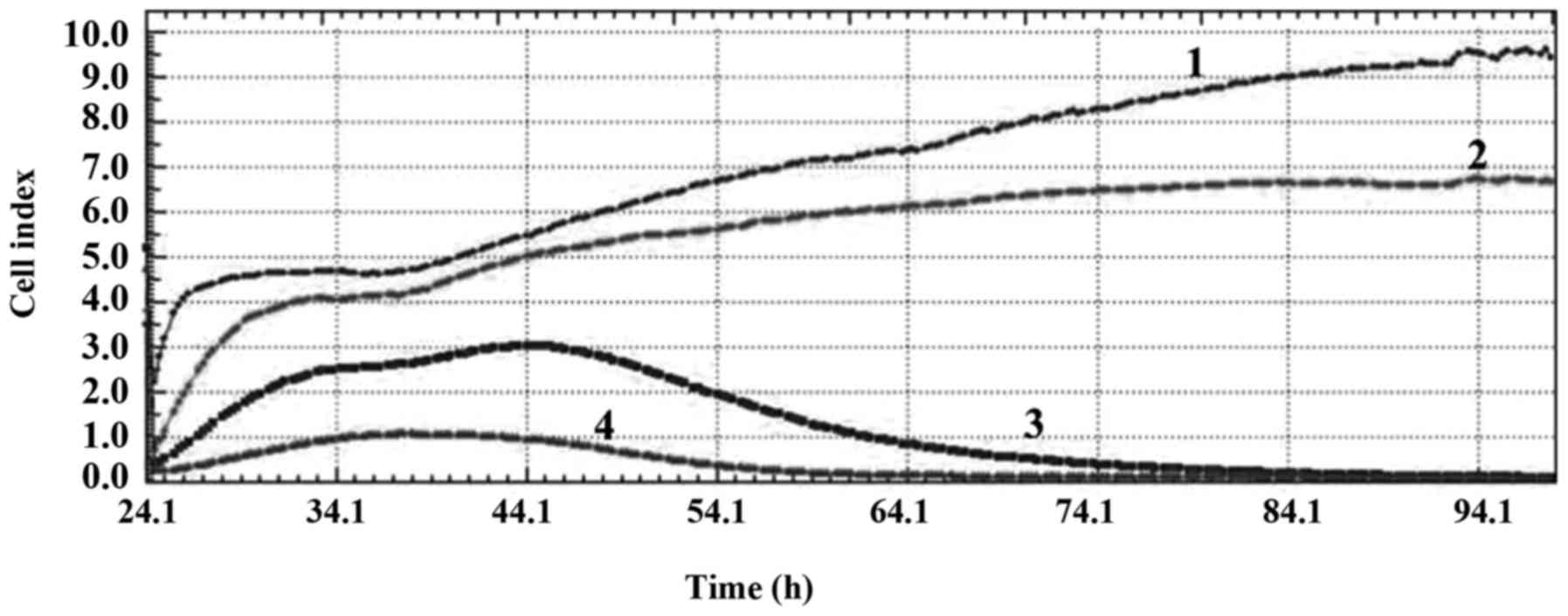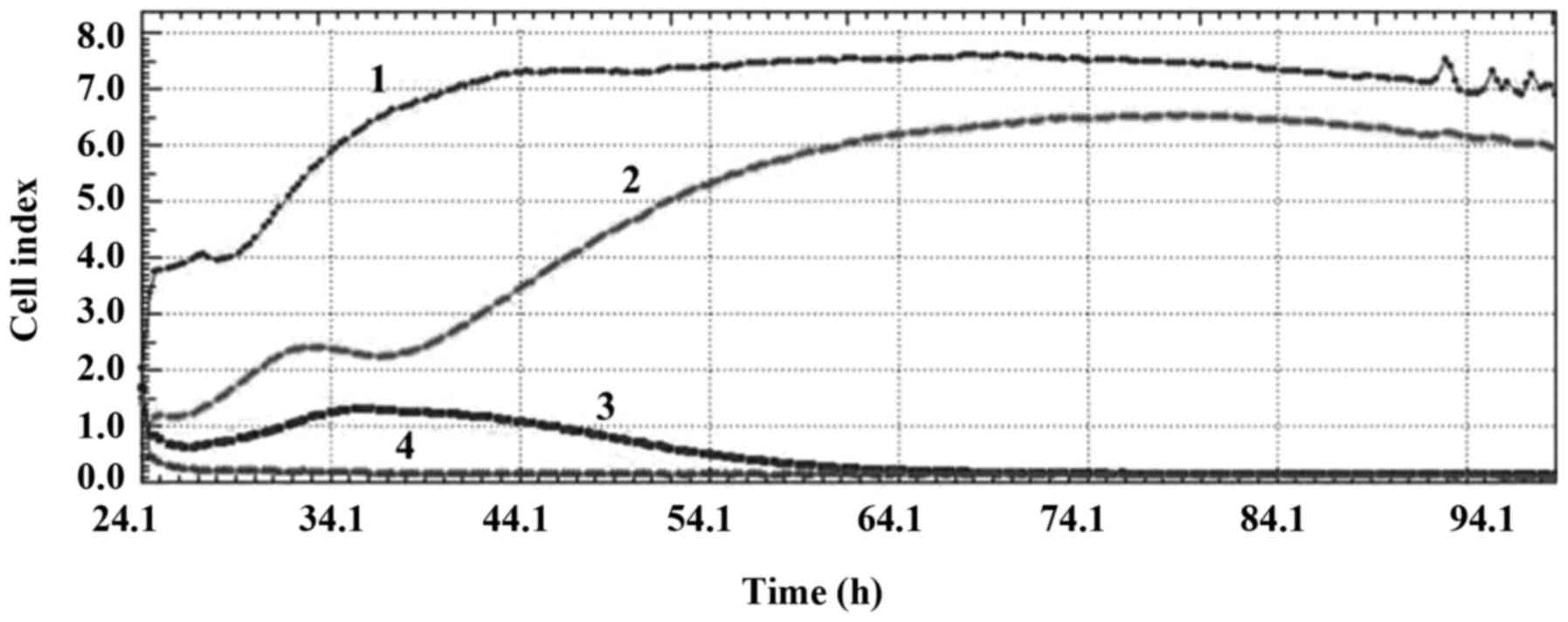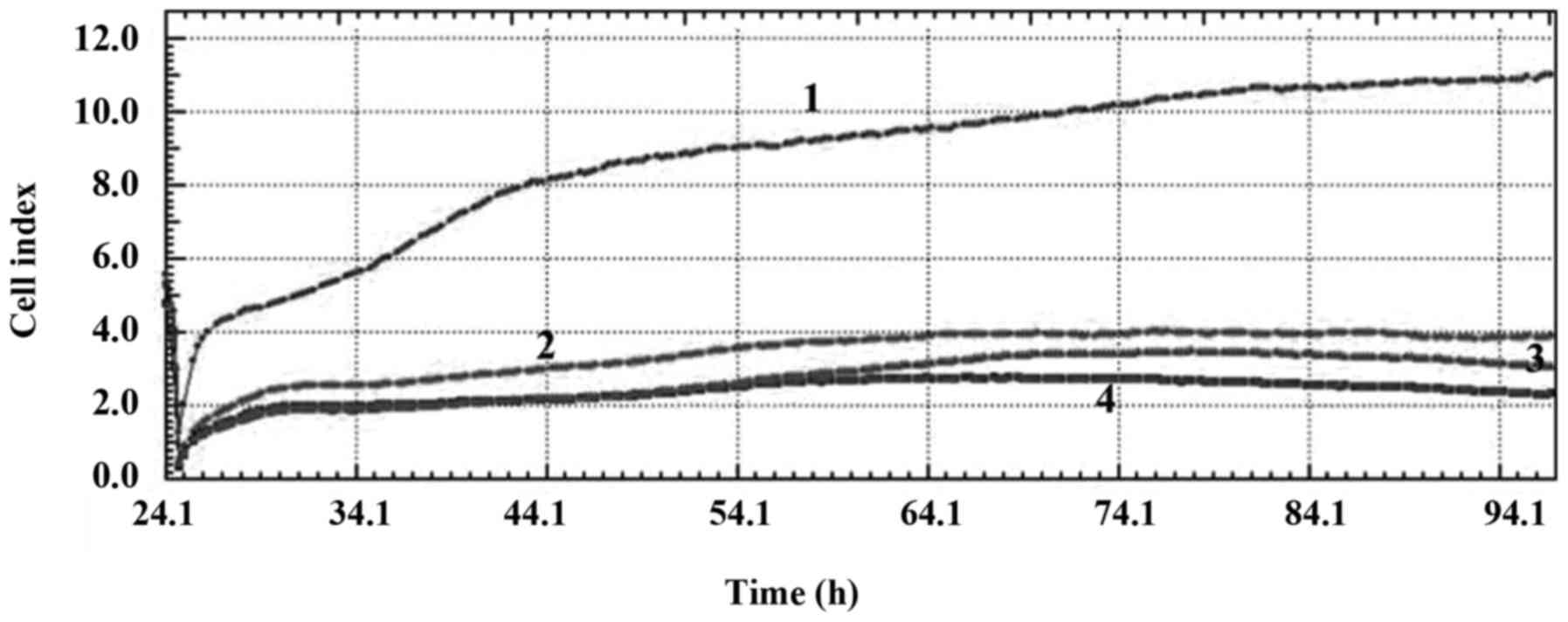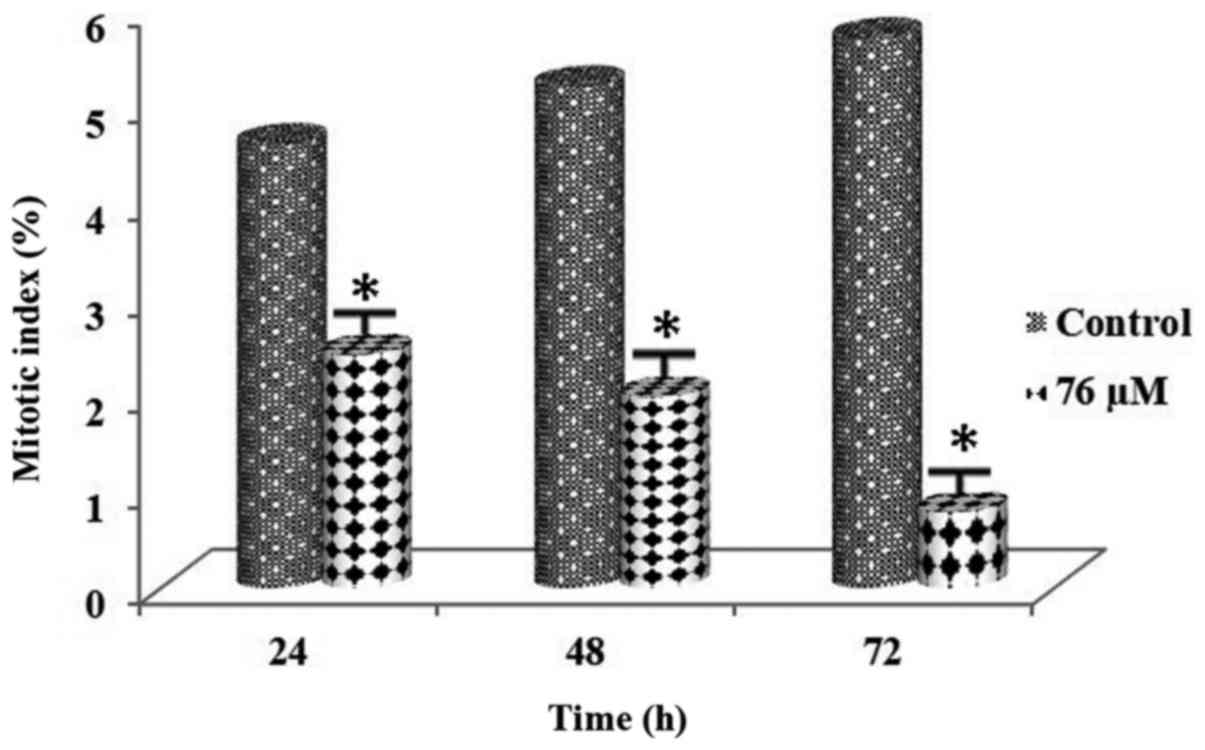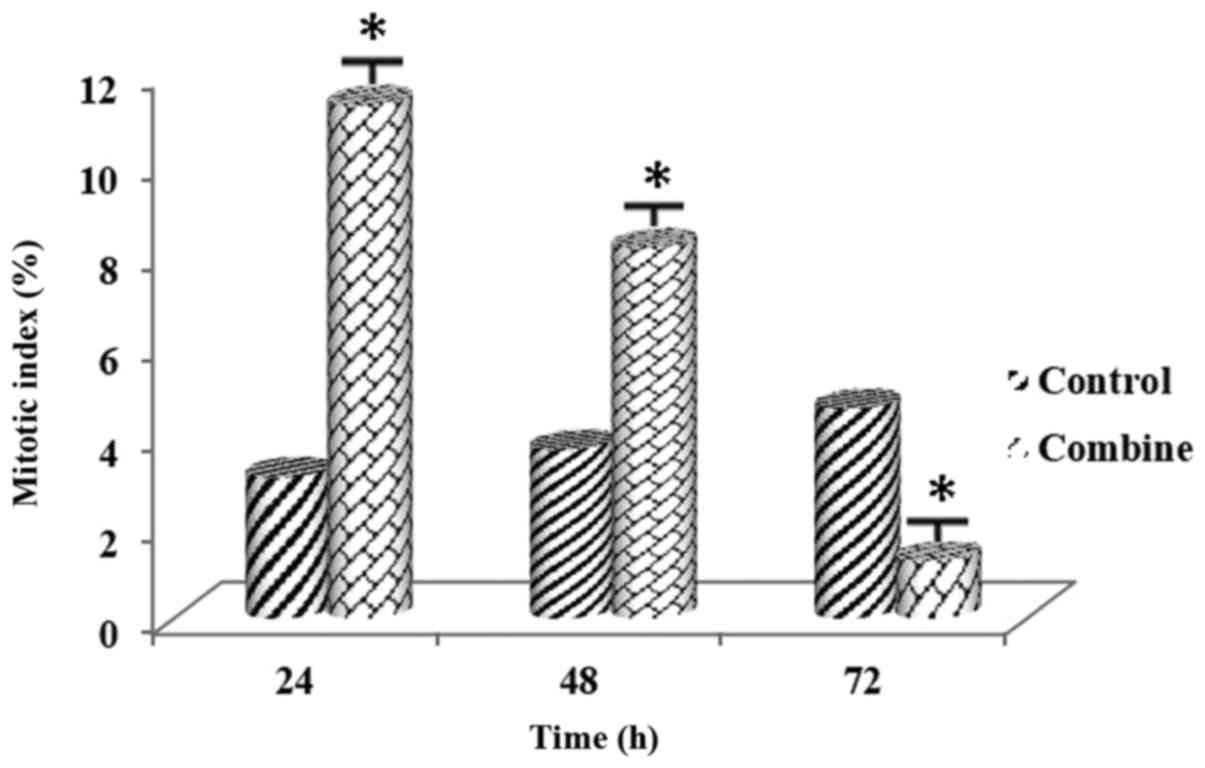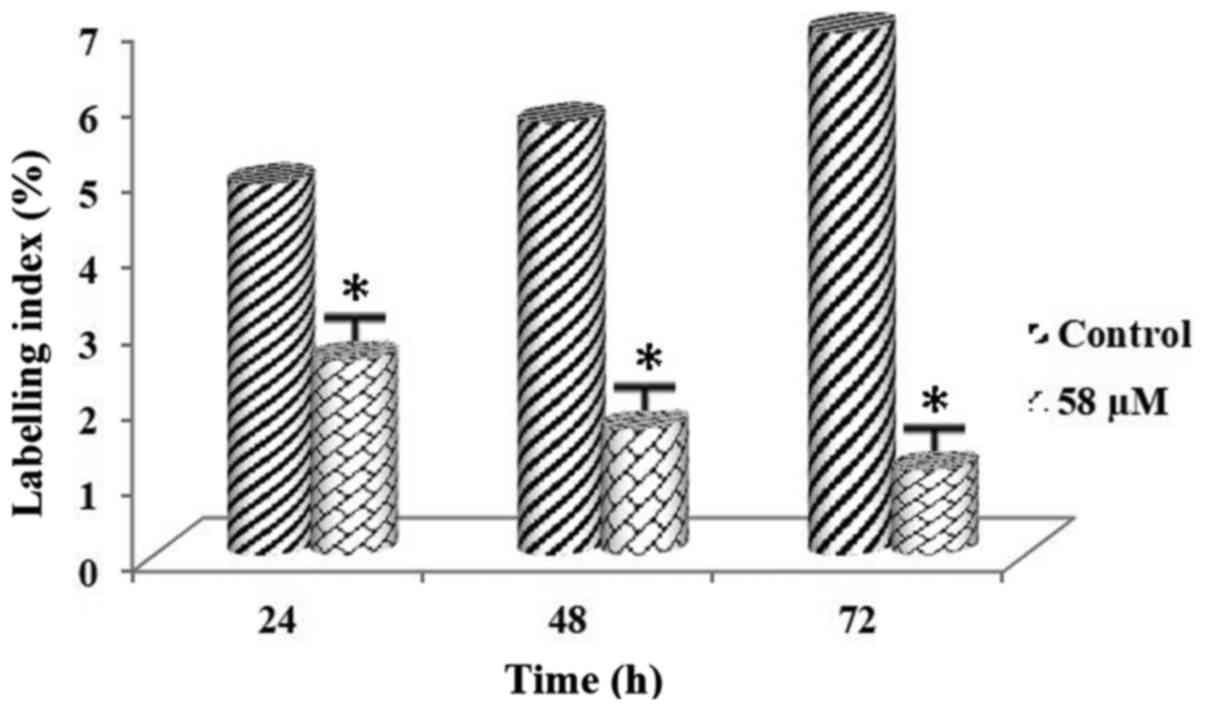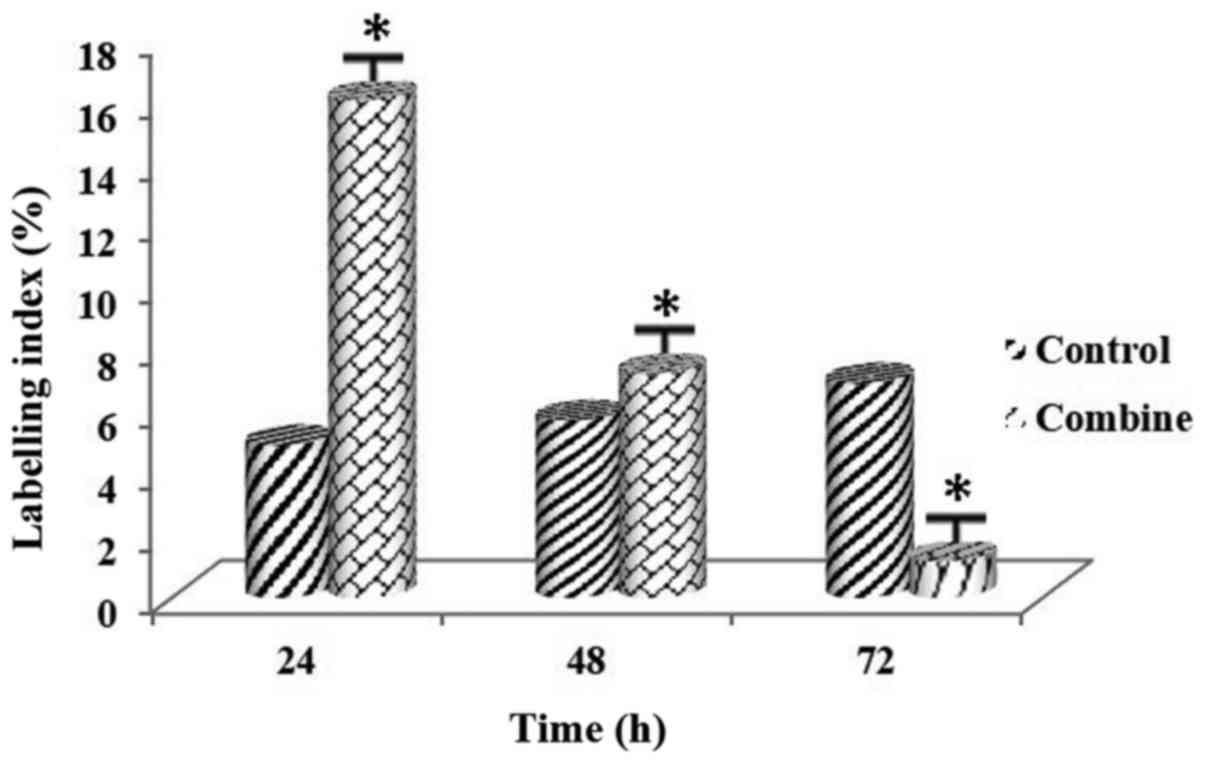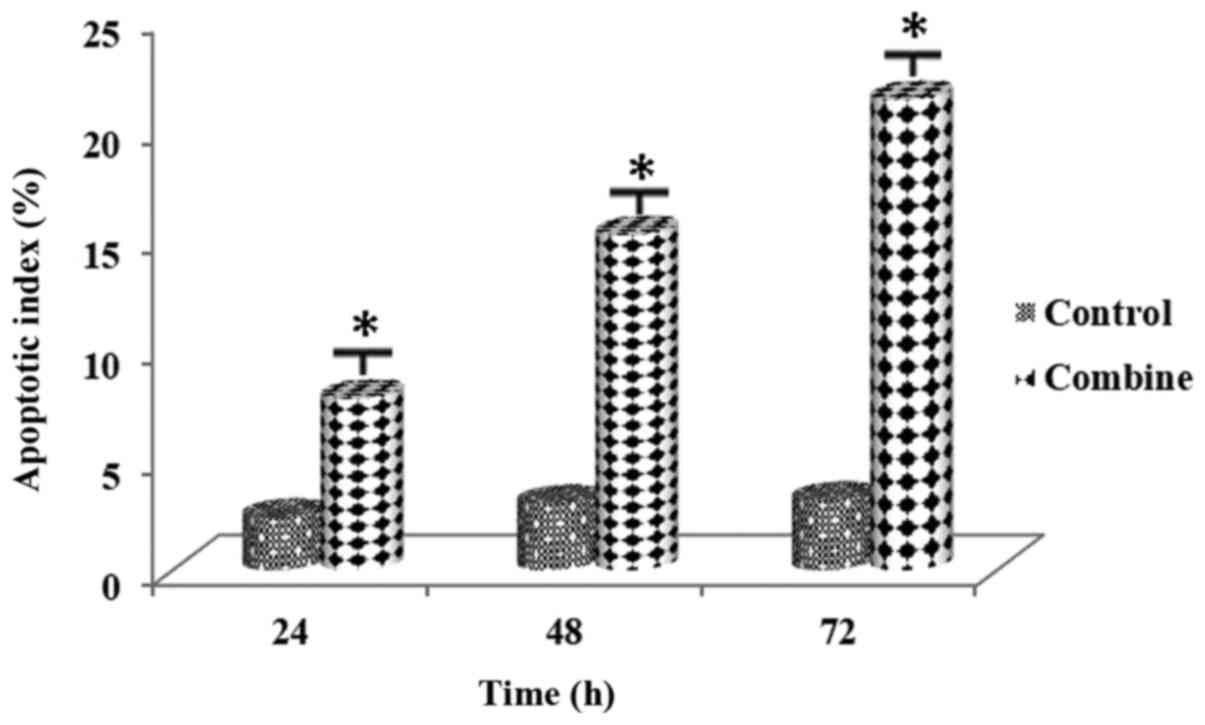In vitro cytotoxic effect of PARP inhibitor alone and in combination with nab‑paclitaxel on triple‑negative and luminal A breast cancer cells
- Authors:
- Published online on: April 12, 2018 https://doi.org/10.3892/or.2018.6364
- Pages: 527-535
Abstract
Introduction
Breast cancer is a heterogeneous disease. Based on comprehensive gene expression profiling, five types of breast cancer have been determined including, luminal A and B, human epidermal growth factor receptor-2 (HER-2)-overexpressing, basal- and normal-like (1). Luminal A breast cancers are characterized by the existence of estrogen receptor (ER), progesterone receptor (PR) and lack of overexpression of HER-2 and Ki-67 (2); triple-negative breast cancers (TNBCs) are characterized by the absence of the ER and PR and lack of overexpression of HER-2 (3). In addition, luminal A breast cancers are associated with a good prognosis and patients with TNBCs exhibit a poor prognosis.
Poly(ADP-ribose) polymerase (PARP) is a family of proteins that have enzymatic features, scaffolding characteristics and the ability to recruit other necessary DNA repair proteins (4). Among these, PARP1 and 2 are well known and they are critical for base excision repair (BER) function. The function of BER is to repair the breaks that are found in single-strand DNA and BER inhibition can result in cell death. Thus, PARP proteins make ideal targets for anticancer treatment. PARP inhibitors interfere with BER and DNA repair, and PARP inhibitors can influence the death of tumor cells via this pathway (5).
Paclitaxel targeting tubulin is used for the treatment of various types of cancer; however, the use of cremophor in the formulation restricts the utility of this drug. On the other hand, nanoparticle albumin-bound paclitaxel [nab-paclitaxel (Abraxane®); Celgene Corp., Summit, NJ, USA] is solvent-free; it minimizes hypersensitivity reactions and has the potential to inhibit other solvent-related toxicities such as neutropenia (6–8).
The aim of the present study was to investigate the effect of a PARP inhibitor alone and in combination with nab-paclitaxel on MDA-MB-231 and MCF-7 cell lines using cell kinetic parameters including cell index (CI), mitotic index (MI), labelling index (LI) and apoptotic index (AI).
Materials and methods
Cell culture
MDA-MB-231 and MCF-7 cells were grown in Dulbecco's modified Eagle's medium (DMEM, high glucose) (Gibco: Thermo Fisher Scientific, Inc., Waltham, MA, USA) supplemented with 2 mM L-glutamine and 10% fetal bovine serum (FBS; Gibco: Thermo Fisher Scientific, Inc.) plus antibiotics in a humidified atmosphere with 5% CO2 in air. The pH of the medium was adjusted to 7.4 with NaHCO3.
Inhibitor and drug concentrations
PARP inhibitor and nab-paclitaxel concentrations that were used in the present study were determined as 50, 75 and 100 µM for PARP inhibitor concentrations and 5.8, 11.72 and 17.59 µM for nab-paclitaxel concentrations. At first, 1 mM stock solution was prepared by dilution of a stock solution for both inhibitor and the drug.
Cell index
Experiments were carried out using the xCELLigence Real-Time Cell Analysis (RTCA) DP instrument (Roche Diagnostics GmbH, Mannheim, Germany) which was placed in a humidified incubator at 37°C with 5% CO2. Cytotoxicity experiments were performed using modified 16-well plates (E-Plate; Roche Diagnostics GmbH). Microelectrodes were attached at the bottom of the wells for impedance-based detection of attachment, spreading and proliferation of the cells. The background impedance signal was evaluated with 100 µl of cell culture medium/well. The final volume in a single well was adjusted to 200 µl of cell culture medium by adding an additional 100 µl of medium containing cells. Cell numbers were 5,000 cells/well for MDA-MB-231 and 10,000 cells/well for MCF-7. The impedance was recorded in 15-min intervals. Twenty hours after seeding, the drug concentrations were added to the culture. All incubations were performed at a volume of 200 µl.
Mitotic index
MDA-MB-231 and MCF-7 cells were plated on coverslips and treated with the control or experimental agents for 0–72 h. The cells were then fixed using Carnoy fixative (ethanol:acetic acid, 3:1) and stained using the Feulgen method. The number of cells in the mitotic phases (n) per total cells (3,000-3,500; C) was determined by the same individual. The MI (%) was scorred using the following formula: MI = (n/C) ×100.
3H-thymidine LI analysis
For 3H-thymidine LI analysis, which detects cells in the S phase, MDA-MB-231 and MCF-7 cells were seeded into round coverslips which were in 24-well plates at a density of 2×104 cells/well and incubated for 24 h. Then the experimental treatments were applied to cells. At the end of the experimental period, cells were treated with medium containing 1 µCi/ml 3H-thymidine for 20 min for evaluation of the LI.
Autoradiography
After exposure for 3 days at 4°C, autoradiograms were developed with a D-19 developer solution and fixed with Fixaj B (both from Kodak, Rochester, NY, USA). The coverslips were evaluated after being stained with Giemsa for 3 min. The labeling index (LI) was determined by counting at least 3,000 cells/coverslip. The index is expressed as the percentage of labeled nuclei.
Apoptotic index
MDA-MB-231 and MCF-7 cells were collected and then fixed with methanol:phosphate-buffered saline (PBS) (1:1) and methanol. The cells were fixed and mounted on slides, stained with 0.5 mg/ml DAPI for 30 min and washed with PBS. Nuclear morphology of the cells was visualized using an Olympus fluorescence microscope (Olympus Corp., Tokyo, Japan). For evaluation of the AI, at least 100 cells were counted for the control and each of the experimental groups.
Statistical analysis
CI, MI, AI and LI values were evaluated relative to the controls and to each other. For this reason, the values obtained from all experimental groups were analyzed using the one-way ANOVA test. The significance between the control and the experimental groups was determined by the Dunnett's test and the significance between the experimental groups was determined by the Student's t-test. P<0.01 was considered to indicate a statistically significant result.
Results
Cell index
CI values obtained from xCELLigence RTCA system demonstrated that the PARP inhibitor at both concentrations alone and in combination with nab-paclitaxel had significant anti-proliferative effects on both MDA-MB-231 and MCF-7 cell lines. These values also showed that while the PARP inhibitor at a concentration of 50 µM had a cytostatic effect, the PARP inhibitor at concentrations 75 and 100 µM had DNA damaging effect on the MDA-MB-231 cell line (Fig. 1). PARP inhibitor at a concentration of 50 µM had an anti-mitotic effect, the PARP inhibitor at a concentration of 75 µM had a DNA damaging effect and the PARP inhibitor at a concentration of 100 µM had a cytoskeletal effect on the MCF-7 cell line (Fig. 2).
Combination treatment of the PARP inhibitor at different concentrations with nab-paclitaxel had significant anti-proliferative effects on the MDA-MB-231 and MCF-7 cell lines. The CI values demonstrated that the combination treatment with all concentrations had a cytostatic effect on the MDA-MB-231 cell line and a cytoskeletal effect on the MCF-7 cell line (Figs. 3 and 4).
Mitotic index
Following administration of the PARP inhibitor at a concentration of 58 µM in MDA-MB-231 cells and administration of the PARP inhibitor at a concentration of 76 µM in MCF-7 cells for 0–72 h, 3,000 cells were counted for both the control and the experimental groups. MI values of these concentrations are shown in Tables I and II. In addition, MI values for both cell lines showed that there was a significant decrease in the mitosis rates in the cell lines (Figs. 5 and 6). The difference was found to be significant between the control and the experimental groups (P<0.01). In addition, a statistically significant difference was noted among all the experimental groups (P<0.01).
Following the combined administration of the PARP inhibitor at a concentration of 58 µM and nab-paclitaxel at a concentration of 5.8 µM in the MDA-MB-231 cells and administration of the PARP inhibitor at a concentration of 76 µM and nab-paclitaxel at a concentration of 5.8 µM in MCF-7 for 0–72 h, 3,000 cells were counted both for the control and the experimental groups. MI values of these concentrations are shown in Tables III and IV. MI values for both cell lines demonstrated that there was a significant increase at 24 h and a significant decrease at 72 h (Figs. 7 and 8). The difference was significant between the control and the experimental groups (P<0.01). In addition, a statistically significant difference was noted among all the experimental groups (P<0.01).
Table III.MI (%) values of MDA-MB-231 cells treated with the combination of 58 µM dose of the PARP inhibitor and 5.8 µM nab-paclitaxel for 0–72 h. |
Table IV.MI (%) values of MCF-7 cells treated with the combination of 76 µM dose of the PARP inhibitor and 5.8 µM nab-paclitaxel for 0–72 h. |
Labelling index
Following administration of the PARP inhibitor at a concentration of 58 µM in MDA-MB-231 cells and administration of the PARP inhibitor at a concentration of 76 µM in MCF-7 cells for 0–72 h, 3,000 cells were counted both for the control and the experimental groups. LI values of these concentrations are shown in Tables V and VI. LI values belonging to both cell lines demonstrated that there was a significant decrease in DNA synthesis rates of the cell lines (Figs. 9 and 10). The difference was significant between the control and the experimental groups (P<0.01). In addition, a statistically significant difference was noted among all the experimental groups (P<0.01).
Following the combined administration of the PARP inhibitor at a concentration of 58 µM and nab-paclitaxel at a concentration of 5.8 µM in MDA-MB-231 and the combined administration of the PARP inhibitor at a concentration of 76 µM and nab-paclitaxel at a concentration of 5.8 µM in MCF-7 cells for 0–72 h, 3,000 cells were counted both for the control and the experimental groups. LI values of these concentrations are shown in Tables VII and VIII. LI values for both cell lines indicated that there was an increase at 24 h, and a significant decrease at 72 h (Figs. 11 and 12). The difference was significant between the control and the experimental groups (P<0.01). In addition, a statistically significant difference was noted among all the experimental groups (P<0.01).
Table VII.LI (%) values of MDA-MB-231 cells treated with the combination of 58 µM dose of the PARP inhibitor and 5.8 µM nab-paclitaxel for 0–72 h. |
Table VIII.LI (%) values of MCF-7 cells treated with the combination of 76 µM dose of the PARP inhibitor and 5.8 µM nab-paclitaxel for 0–72 h. |
Apototic index
Following administration of the PARP inhibitor at a concentration of 58 µM in MDA-MB-231 cells and the PARP inhibitor at a concentration of 76 µM in MCF-7 cells for 0–72 h, 250 cells were counted both for the control and the experimental groups. AI values of these concentrations are shown in Table IX and X. Also AI values for both cell lines demonstrated that there was a significant increase in apoptosis rates of the cell lines (Figs. 13 and 14). The difference was significant between the control and the experimental groups (P<0.01). In addition, statistically significant difference was noted among all the experimental groups (P<0.01).
Table IX.AI (%) values of MDA-MB-231 cells treated with 58 µM dose of the PARP inhibitor for 0–72 h. |
Following the combined administration of the PARP inhibitor at a concentration of 58 µM and nab-paclitaxel at a concentration of 5.8 µM in MDA-MB-231 and the combined administration of the PARP inhibitor at a concentration of 76 µM and nab-paclitaxel at a concentration of 5.8 µM in MCF-7 cells for 0–72 h, 250 cells were counted both for the control and the experimental groups. AI values of these concentrations are shown in Tables XI and XII. AI values for both cell lines demonstrated that there was a significant increase in apoptosis rates of the cell lines (Figs. 15 and 16). The difference was significant between the control and the experimental groups (P<0.01). In addition, statistically significant difference was noted among all the experimental groups (P<0.01).
Table XI.AI (%) values of MDA-MB-231 cells treated with the combination of 58 µM dose of the PARP inhibitor and 5.8 µM nab-paclitaxel for 0–72 h. |
Table XII.AI (%) values of MCF-7 cells treated with the combination of 76 µM dose of the PARP inhibitor and 5.8 µM nab-paclitaxel for 0–72 h. |
Discussion
Breast cancer is a heterogeneous disease. It consists of several distinct entities having significantly different biological characteristics and clinical behaviors (9). TNBC is also a disease with different characteristics and the standard treatment is cytotoxic chemotherapy. Recent advances in the field of medicine have demonstrated that multiple TNBC subtypes exist as well (10).
Today several limitations related to cancer treatment exist. One of these limitations is the use of conventional agents that not only target cancer cells, but also result in high toxicity, thus precluding effective treatment. Elucidation of cancer-causing mechanisms in recent studies has led to the discovery of novel key molecules and pathways which have the potential to become successful targets for the elimination of cancer cells only (11). Although TNBCs are reported to respond to neoadjuvant chemotherapy, the survival of patients with such tumors is poor and their management may therefore require a more aggressive alternative intervention (12,13).
Upregulation of PARP1 is expressed by TNBCs (14). This finding indicates that TNBCs are sensitive to PARP inhibitors (5). The use of PARP inhibitors in combination with systemic therapies for targeting DNA repair deficiencies continues to present a significant clinical interest (15). PARP1 inhibitors may demonstrate synergism with various anti-metabolites and anti-mitotic agents, as well. PARP1 inhibitors are also promising agents based on the fact that they appear to possess few side-effects, and also protect normal tissues. Indeed, reports from clinical trials performed with PARP1 inhibitors indicate that phase I studies have successfully been completed, and phase II studies have been initiated for various ischemic disorders (16). Preclinical studies have demonstrated that breast cancer cell lines having a TN phenotype appear to be more sensitive to PARP inhibitors in comparison to non-TNBC cells (17).
Preclinical studies indicate that a combination of PARP inhibitor and various anti-proliferative agents yielded a more sustainable recession of cell proliferation; it also enhanced the retention of DNA damage and ultimately led to an increase in apoptosis for pancreatic and TNBC cell lines (17,18).
The primary mechanism of the action of paclitaxel has been intensively investigated. It leads to the promotion of polymerization of tubulin heterodimers to microtubules. When paclitaxel is administered at high concentrations, it both stabilizes microtubules and also increases the total polymer mass (19). However, these concentrations are far higher than what is needed for the inhibition of microtubule functions (20). Paclitaxel suppresses dynamic changes in microtubules at clinically relevant concentrations, therefore, it leads to mitotic arrest (21). Paclitaxel has several accompanying toxic effects (22). Nab-paclitaxel is a novel formulation of paclitaxel, which consists of a colloidal suspension formed by albumin-bound paclitaxel nanoparticles (23). It has been shown in phase III trials that nab-paclitaxel is a next-generation taxane having a superior therapeutic index compared to paclitaxel (8,24).
The combination of paclitaxel with PARP inhibitor olaparib has also been investigated in a phase I/II trial in TNBC. Nineteen patients, most of whom were previously administered taxane therapy were treated with daily 200 mg of olaparib (oral) in combination with paclitaxel 90 mg/m2 (i.v. drip) weekly for 3–4 weeks. When we consider the previous taxane exposure, olaparib usage may be successful in overcoming taxane resistance (25).
Paclitaxel is commonly being used in several subtypes of cancer and a PARP inhibitor/PXL combination was suggested as an alternative therapeutic approach in various patient populations (26,27).
In a study conducted by Cetin and Topcul, the effectiveness of nab-paclitaxel and liposomal cisplatin combination was investigated in MDA-MB-231 and MCF-7 cell lines, and as a result a significant decrease in cell viability and cell index values for both cell lines was observed. MI and LI values of both cell lines were seen to increase at 24 h, and then decreased significantly at 72 h. There was a significant increase in AI values, as well (28).
In the present study, we demonstrated that there was a significant decrease in cell, mitotic and labelling indices and a significant increase in the AI values specifically at 72 h. The results of the present study seem to be concordant with the above mentioned studies and addition of nab-paclitaxel to the treatment combination showed similar profiles with the above mentioned previous findings.
Acknowledgements
The present study was supported by the Scientific Research Projects Coordination Unit of Istanbul University (project no. 41832).
Funding
No funding was received.
Availability of data and materials
Not applicable.
Authors' contributions
MT and İÇ conceived and designed the study. MT and İÇ performed xCelligence experiments. MT performed labelling index experiments. İÇ performed mitotic index experiments. Apoptotic index experiments were performed by SÖT. Statistical analyses were performed by MÖKO. All authors reviewed and edited the manuscript. All authors read and approved the manuscript and agree to be accountable for all aspects of the research in ensuring that the accuracy or integrity of any part of the work are appropriately investigated and resolved.
Ethics approval and consent to participate
Not applicable.
Consent for publication
Not applicable.
Competing interests
The authors declare that they have no competing interests.
References
|
Sørlie T, Tibshirani R, Parker J, Hastie T, Marron JS, Nobel A, Deng S, Johnsen H, Pesich R, Geisler S, et al: Repeated observation of breast tumor subtypes in independent gene expression data sets. Proc Natl Acad Sci USA. 100:8418–8423. 2003. View Article : Google Scholar : PubMed/NCBI | |
|
Cheang MC, Chia SK, Voduc D, Gao D, Leung S, Snider J, Watson M, Davies S, Bernard PS, Parker JS, et al: Ki67 index, HER2 status, and prognosis of patients with luminal B breast cancer. J Natl Cancer Inst. 101:736–750. 2009. View Article : Google Scholar : PubMed/NCBI | |
|
Cetin I and Topcul M: Triple negative breast cancer. Asian Pac J Cancer Prev. 15:2427–2431. 2014. View Article : Google Scholar : PubMed/NCBI | |
|
Rouleau M, Patel A, Hendzel MJ, Kaufmann SH and Poirier GG: PARP inhibition: PARP1 and beyond. Nat Rev Cancer. 10:293–301. 2010. View Article : Google Scholar : PubMed/NCBI | |
|
Weil MK and Chen AP: PARP inhibitor treatment in ovarian and breast cancer. Curr Probl Cancer. 35:7–50. 2011. View Article : Google Scholar : PubMed/NCBI | |
|
Ibrahim NK, Desai N, Legha S, Soon-Shiong P, Theriault RL, Rivera E, Esmaeli B, Ring SE, Bedikian A, Hortobagyi GN, et al: Phase I and pharmacokinetic study of ABI-007, a Cremophor-free, protein-stabilized, nanoparticle formulation of paclitaxel. Clin Cancer Res. 8:1038–1044. 2002.PubMed/NCBI | |
|
ten Tije AJ, Verweij J, Loos WJ and Sparreboom A: Pharmacological effects of formulation vehicles: Implications for cancer chemotherapy. Clin Pharmacokinet. 42:665–685. 2003. View Article : Google Scholar : PubMed/NCBI | |
|
Gradishar WJ, Tjulandin S, Davidson N, Shaw H, Desai N, Bhar P, Hawkins M and O'Shaughnessy J: Phase III trial of nanoparticle albumin-bound paclitaxel compared with polyethylated castor oil-based paclitaxel in women with breast cancer. J Clin Oncol. 23:7794–7803. 2005. View Article : Google Scholar : PubMed/NCBI | |
|
Reis-Filho JS and Tutt ANJ: Triple negative tumours: A critical review. Histopathology. 52:108–118. 2008. View Article : Google Scholar : PubMed/NCBI | |
|
Saha P and Nanda R: Concepts and targets in triple-negative breast cancer: Recent results and clinical implications. Ther Adv Med Oncol. 8:351–359. 2016. View Article : Google Scholar : PubMed/NCBI | |
|
Topcul M and Cetin I: Endpoint of cancer treatment: Targeted therapies. Asian Pac J Cancer Prev. 15:4395–4403. 2014. View Article : Google Scholar : PubMed/NCBI | |
|
Rouzier R, Perou CM, Symmans WF, Ibrahim N, Cristofanilli M, Anderson K, Hess KR, Stec J, Ayers M, Wagner P, et al: Breast cancer molecular subtypes respond differently to preoperative chemotherapy. Clin Cancer Res. 11:5678–5685. 2005. View Article : Google Scholar : PubMed/NCBI | |
|
Carey LA, Dees EC, Sawyer L, Gatti L, Moore DT, Collichio F, Ollila DW, Sartor CI, Graham ML and Perou CM: The triple negative paradox: Primary tumor chemosensitivity of breast cancer subtypes. Clin Cancer Res. 13:2329–2334. 2007. View Article : Google Scholar : PubMed/NCBI | |
|
O'Shaughnessy J, Yoffe M, Osborne C, Blum J, Rocha C, Ossovskaya V, Sherman B and Bradley C: Triple negative breast cancer: A phase 2, multi-center, open-label, randomized trial of gemcitabine/carboplatin (G/C), with or without BSI-201, a PARP inhibitor. Cancer Res. 69 Suppl:21202009. View Article : Google Scholar | |
|
Dent RA, Lindeman GJ, Clemons M, Wildiers H, Chan A, McCarthy NJ, Singer CF, Lowe ES, Watkins CL and Carmichael J: Phase I trial of the oral PARP inhibitor olaparib in combination with paclitaxel for first- or second-line treatment of patients with metastatic triple-negative breast cancer. Breast Cancer Res. 15:R882013. View Article : Google Scholar : PubMed/NCBI | |
|
Graziani G and Szabó C: Clinical perspectives of PARP inhibitors. Pharmacol Res. 52:109–118. 2005. View Article : Google Scholar : PubMed/NCBI | |
|
Hastak K, Alli E and Ford JM: Synergistic chemosensitivity of triple-negative breast cancer cell lines to poly(ADP-Ribose) polymerase inhibition, gemcitabine, and cisplatin. Cancer Res. 70:7970–7980. 2010. View Article : Google Scholar : PubMed/NCBI | |
|
Jacob DA, Bahra M, Langrehr JM, Boas-Knoop S, Stefaniak R, Davis J, Schumacher G, Lippert S and Neumann UP: Combination therapy of poly (ADP-ribose) polymerase inhibitor 3-aminobenzamide and gemcitabine shows strong antitumor activity in pancreatic cancer cells. J Gastroenterol Hepatol. 22:738–748. 2007.PubMed/NCBI | |
|
Schiff PB and Horwitz SB: Taxol stabilizes microtubules in mouse fibroblast cells. Proc Natl Acad Sci USA. 77:1561–1565. 1980. View Article : Google Scholar : PubMed/NCBI | |
|
Jordan MA and Wilson L: Microtubules and actin filaments: Dynamic targets for cancer chemotherapy. Curr Opin Cell Biol. 10:123–130. 1998. View Article : Google Scholar : PubMed/NCBI | |
|
Jordan MA, Toso RJ, Thrower D and Wilson L: Mechanism of mitotic block and inhibition of cell proliferation by taxol at low concentrations. Proc Natl Acad Sci USA. 90:9552–9556. 1993. View Article : Google Scholar : PubMed/NCBI | |
|
Crown J and O'Leary M: The taxanes: An update. Lancet. 355:1176–1178. 2000. View Article : Google Scholar : PubMed/NCBI | |
|
Kratz F: Albumin as a drug carrier: Design of prodrugs, drug conjugates and nanoparticles. J Control Release. 132:171–183. 2008. View Article : Google Scholar : PubMed/NCBI | |
|
Untch M, Jackisch C, Schneeweiss A, Conrad B, Aktas B, Denkert C, Eidtmann H, Wiebringhaus H, Kümmel S, Hilfrich J, et al: German Breast Group (GBG); Arbeitsgemeinschaft Gynäkologische Onkologie-Breast (AGO-B) Investigators: Nab-paclitaxel versus solvent-based paclitaxel in neoadjuvant chemotherapy for early breast cancer (GeparSepto-GBG 69): A randomised, phase 3 trial. Lancet Oncol. 17:345–356. 2016. View Article : Google Scholar : PubMed/NCBI | |
|
Giaccone G, Rajan A, Kelly RJ, Gutierrez M, Kummar S, Yancey M, Ji JJ, Zhang Y, Parchment RE and Doroshow JH: A phase I combination study of olaparib (AZD2281; KU-0059436) and cisplatin (C) plus gemcitabine (G) in adults with solid tumors. J Clin Oncol. 28 suppl 15:30272010. View Article : Google Scholar | |
|
Haince JF, Kozlov S, Dawson VL, Dawson TM, Hendzel MJ, Lavin MF and Poirier GG: Ataxia telangiectasia mutated (ATM) signaling network is modulated by a novel poly(ADP-ribose)-dependent pathway in the early response to DNA-damaging agents. J Biol Chem. 282:16441–16453. 2007. View Article : Google Scholar : PubMed/NCBI | |
|
Kang B, Guo RF, Tan XH, Zhao M, Tang ZB and Lu YY: Expression status of ataxia-telangiectasia-mutated gene correlated with prognosis in advanced gastric cancer. Mutat Res. 638:17–25. 2008. View Article : Google Scholar : PubMed/NCBI | |
|
Cetin I and Topcul MR: In vitro antiproliferative effects of nab-paclitaxel with liposomal cisplatin on MDA-MB-231 and MCF-7 breast cancer cell lines. J BUON. 22:347–354. 2017.PubMed/NCBI |



